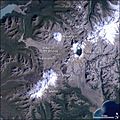Katmai National Park facts for kids
Katmai National Park is a special place in southern Alaska, United States. It was created in 1918 to protect a unique area around Mount Katmai and the famous Valley of Ten Thousand Smokes. This valley was formed by a giant volcano eruption, leaving behind amazing landscapes of lava and ash. Even today, the volcano is still active! The park is also home to thousands of brown bears and lots of salmon, living among tundras, forests, sparkling lakes, and tall mountains.
Contents
A Land Shaped by Volcanoes
Katmai National Park is famous for its incredible volcanic history. The most important event happened in 1912 when the Novarupta volcano erupted. This was one of the biggest volcanic eruptions in modern history!
The Novarupta Eruption
On June 6, 1912, the Novarupta volcano exploded with incredible force. It sent huge clouds of ash and gas high into the sky. This eruption lasted for about 60 hours, changing the landscape forever. The ash covered everything for miles around, and the ground shook with earthquakes.
Valley of Ten Thousand Smokes
The eruption created a new valley called the Valley of Ten Thousand Smokes. This name came from the thousands of steam vents, or "fumaroles," that appeared after the eruption. Hot gases and steam rose from cracks in the ground, making the valley look like it was smoking. Over time, most of these vents have cooled down, but the valley remains a powerful reminder of the volcano's strength. It's a vast area covered in ash and lava flows, looking almost like another planet.
Active Volcanoes Today
Even though Novarupta is quiet now, other volcanoes in the park are still active. Mount Katmai, Mount Trident, and Mount Mageik are some of the volcanoes that are part of the Aleutian Range. Scientists continue to study these volcanoes to understand how they work and to monitor any changes.
Wildlife of Katmai National Park
Katmai National Park is a paradise for wildlife, especially for its famous brown bears and the salmon they love to eat.
Brown Bears
The park is home to one of the largest populations of brown bears in the world. Thousands of these amazing animals live here. They are often seen along the rivers, especially at places like Brooks Falls.
Bear Life Cycle and Feeding
Bears in Katmai spend their summers eating as much as they can to get ready for winter. Their main food source is salmon. These fish swim upriver from the ocean to lay their eggs. This journey is called the salmon run. Bears gather at waterfalls and rapids, waiting to catch the fish as they jump out of the water. It's an incredible sight to see!
Salmon
Salmon are vital to the ecosystem of Katmai. They provide food for bears, eagles, and many other animals. There are several types of salmon found in the park's rivers and lakes, including sockeye salmon. Their journey from the ocean to their spawning grounds is a natural wonder.
Exploring the Park
Katmai National Park offers many ways to experience its wild beauty. Most visitors arrive by floatplane, landing on the park's lakes.
Activities for Visitors
- Bear Watching: This is one of the most popular activities. Visitors can watch bears safely from special viewing platforms at Brooks Falls.
- Fishing: Anglers can enjoy fishing for salmon and trout in the park's clear waters.
- Hiking: There are trails that lead through different parts of the park, including the Valley of Ten Thousand Smokes.
- Camping: For those who want to stay longer, there are designated camping areas.
Images for kids
-
A brown bear in Hallo Bay, Katmai National Park, Alaska
-
Pyroclastic flow deposits in the Valley of Ten Thousand Smokes
-
Mountains of the Aleutian Range from a floatplane flying to Brooks Camp
-
Katmai National Park Geologic map, where nig is the Episode I valley-filling ignimbrite of 6–7 June 1912., and nrd is the Novarupta rhyolite dome.
See also
 In Spanish: Parque nacional y reserva Katmai para niños
In Spanish: Parque nacional y reserva Katmai para niños













